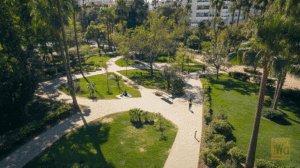Estepona’s Hidden Historical Gems
Nestled along the sun-kissed Costa del Sol, Estepona is not just a picturesque coastal town but a treasure trove of hidden historical gems. While many visitors flock to its beautiful beaches and vibrant marina, the town’s rich history often goes unnoticed. Today, we’ll embark on a fascinating journey through time, exploring the lesser-known historical sites that make Estepona a unique destination for history enthusiasts and curious travelers alike.
Unearthing Estepona’s Ancient Past
Estepona’s history dates back thousands of years, with evidence of human settlement from the Paleolithic era. However, it’s the remnants of later civilizations that truly captivate visitors today. One of the most significant historical sites in Estepona is the Roman ruins of Las Torres.
Located just outside the town center, Las Torres offers a glimpse into Estepona’s Roman past. The site features the remains of a Roman villa and thermal baths, showcasing the sophisticated lifestyle of the area’s ancient inhabitants. Visitors can walk among the ruins, imagining the bustling life that once thrived here over 2,000 years ago.
For those interested in prehistoric times, the Dolmen of Corominas is a must-visit. This megalithic tomb, dating back to the Bronze Age, is one of the best-preserved examples of its kind in the region. It’s a testament to the engineering skills of our ancestors and offers a tangible connection to Estepona’s distant past.
Moorish Influence: Castles and Towers
The Moorish period left an indelible mark on Estepona’s landscape and culture. One of the town’s most iconic landmarks from this era is the Torre del Reloj (Clock Tower). Originally part of a larger fortress, this 15th-century tower now stands as a symbol of Estepona’s resilience through the ages.
Another notable Moorish structure is the Castle of San Luis. Although only ruins remain, the site offers panoramic views of the coastline and serves as a poignant reminder of the strategic importance Estepona held during medieval times. The castle’s history is intertwined with tales of battles, sieges, and the eventual Reconquista.
For those seeking to delve deeper into Estepona’s Moorish heritage, a visit to the local museums is highly recommended. Here, artifacts and exhibits bring to life the rich cultural tapestry of Al-Andalus.
Churches and Chapels: Estepona’s Religious Heritage
As we move forward in time, Estepona’s religious buildings offer insight into the town’s post-Reconquista history. The Church of Los Remedios, built in the 18th century, is a beautiful example of Baroque architecture. Its ornate interior and impressive altarpiece make it a must-see for art and architecture enthusiasts.
The Chapel of Calvario, perched on a hill overlooking the town, is another hidden gem. This small, whitewashed chapel not only offers a peaceful retreat but also boasts stunning views of Estepona and the Mediterranean. It’s particularly enchanting during sunset, when the town is bathed in a golden glow.
Industrial Heritage: Estepona’s Sugar Mills
Moving into more recent history, Estepona’s industrial past is preserved in the remains of its sugar mills. The Sugar Factory of San Luis, dating back to the 19th century, stands as a testament to the town’s once-thriving sugar industry. Although no longer operational, the factory’s imposing structure and intricate machinery offer a fascinating glimpse into Estepona’s industrial revolution.
These historical industrial sites provide a stark contrast to the town’s ancient ruins and medieval structures, showcasing the diverse layers of Estepona’s history.
Preserving the Past: Estepona’s Commitment to Heritage
Estepona’s dedication to preserving its historical sites is evident in the ongoing restoration projects and the creation of historical walking tours. The town has invested in making its historical landmarks accessible to visitors while ensuring their preservation for future generations.
The Estepona Archaeological Museum plays a crucial role in this preservation effort. Housing a vast collection of artifacts from various periods, the museum offers a comprehensive overview of the town’s history. From prehistoric tools to Roman sculptures and Moorish ceramics, the exhibits bring Estepona’s past to life.
Experiencing Estepona’s Living History
Beyond the physical remnants of the past, Estepona’s history lives on in its traditions and festivals. The Feria de Estepona, held annually in July, is a vibrant celebration that combines historical reenactments with modern festivities. It’s an excellent opportunity for visitors to experience the town’s cultural heritage firsthand.
For those interested in culinary history, Estepona’s traditional restaurants offer a taste of the past. Many local dishes have roots in ancient recipes, showcasing the enduring influence of various cultures on the town’s gastronomy.
Planning Your Historical Tour of Estepona
To fully appreciate Estepona’s hidden historical gems, consider taking a guided tour. Local historians offer insightful walks through the town, revealing stories and secrets that bring the past to life. These tours often include visits to sites not typically open to the public, providing a unique perspective on Estepona’s history.
For those preferring to explore independently, the tourist office provides detailed maps and information about the town’s historical sites. Many of the landmarks are within walking distance of each other, making it easy to create your own historical itinerary.
When planning your visit, keep in mind that some sites may have limited opening hours or require advance booking. It’s always a good idea to check the latest information before your trip.
Conclusion: A Town Where History Comes Alive
Estepona’s hidden historical gems offer a captivating journey through time, from ancient Roman settlements to Moorish fortifications and beyond. These landmarks not only provide insight into the town’s rich past but also contribute to its unique character and charm.
As you explore Estepona’s historical sites, you’ll discover a town that has successfully preserved its heritage while embracing modernity. Whether you’re a history buff, a culture enthusiast, or simply a curious traveler, Estepona’s historical treasures promise a rewarding and enlightening experience.
So, the next time you visit this beautiful Costa del Sol town, take some time to explore beyond the beaches and discover Estepona’s secret treasures. You’ll find that each stone, each building, and each artifact has a story to tell, weaving together the fascinating tapestry of Estepona’s history.







